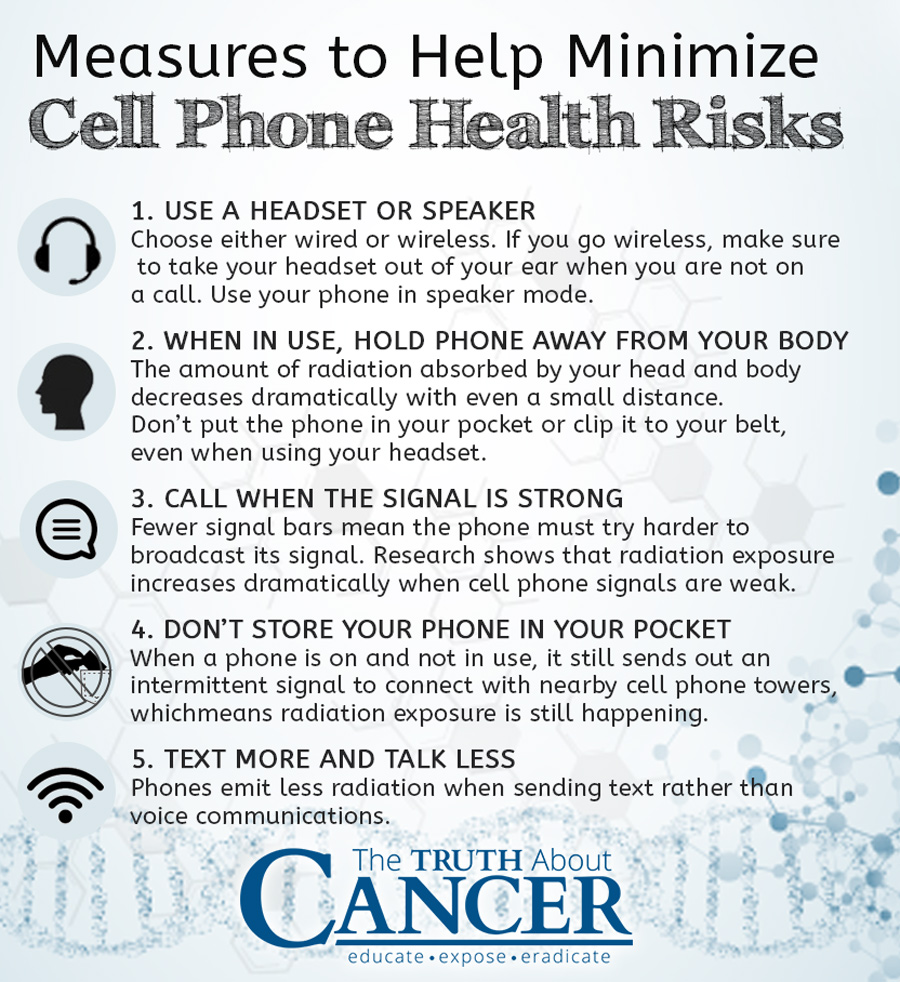Cell phones are handy. Who’s not got a mobile phone these days? In fact, according to the World Bank, three quarters of people on the planet have a cell phone!
But here’s the thing… cell phones emit a type of electromagnetic field (EMF) called radio frequency radiation or microwave radiation. This dangerous EMF radiation is absorbed by our bodies when we carry and use mobile phones.
Cell Phone Radiation and Disease
Independent research links cell phone radiation to a myriad of adverse biological effects, such as DNA chain breaks, Blood-Brain Barrier damage, and disruption of cell metabolism.
These biological effects may translate into symptoms such as fatigue, irritability, headaches, and digestive disorders. Worse still these exposures may lead to disease. Thousands of independent studies now link these exposures to a long list of serious diseases… including cancer.
Even the very conservative World Health Organization has classified radiation exposure from cell phones as a “possible Class 2B carcinogen.”
All that being said, wouldn’t it be good if there was a way of knowing which phones emit the most (and least) radiation? You might be surprised to know that the U.S. government, via the Federal Communications Commission (FCC), requires all cell phone models sold to be tested for their Specific Absorption Rate, or SAR.
What is SAR?
The SAR measures the maximum amount of microwave radiation absorbed by the head or the body. The FCC requires that every new cell phone must have its SAR determined under laboratory conditions. This involves using an artificial model of a large adult male with different fluids to simulate human tissue and a robotic probe to take the measurements.
The SAR, measured in watts per kilogram, represents the maximum amount of energy absorbed in any one gram of tissue in the test model. In the United States the legal limit is 1.60. That’s to say all cell phones sold in the U.S. must have a SAR value of below 1.60 W/kg.
Since most people aren’t willing to give up their mobile phone, it seems logical that knowing the SAR value of the top selling cell phones would be a good idea. That way you could take the SAR into consideration when buying your next cell phone. In order to compare brands and models, I’ve taken the list from InsiderMonkey.com of the 10 best selling smartphones in the U.S. and added in the SAR data below.
SAR Values of the 10 Best Selling Smartphones in the U.S.
Here are the SAR values of the 10 best selling smartphones in the U.S. last year. I’ve sorted them in terms of popularity.
This analysis shows two levels of SAR values: at the head and at the body. There doesn’t appear to be a correlation between the two. That’s to say a low head SAR doesn’t necessarily mean a low body SAR. (Concerning Side Note: If you look at the information, you’ll also notice that the SAR values are lower on the phones sold in the European Union (EUR) than for the exact same models sold in the U.S.)
Head SAR: 1.15 W/kg
Body SAR: 1.16 W/kg
2. iPhone 6
Head: 1.14 W/kg
Body: 1.16 W/kg
3. LG G4
Head: 0.921 W/kg
Body: 0.517 W/kg
Head: 1.58 W/kg
Body: 1.34 W/kg
5. HTC One M9
Head: 0.56 W/kg
Body: 0.35 W/kg
Head: 0.979 W/kg
Body: 1.12 W/kg
Head: 0.21 W/kg
Body: 1.04 W/kg
Head: 1.14 W/kg
Body: 1.16 W/kg
Head: 0.885 W/kg
Body: 1.501 W/kg
10. Google Nexus 6
Head: 0.86 W/kg
Body: 0.36 W/kg
What Does This SAR Analysis Tell Us?
According to this analysis, if you were most concerned about radiation absorption to the head (e.g. you talk on your cell phone a lot) you would purchase the Samsung Galaxy Note 4 which has a head SAR of 0.21 W/kg. If you were most concerned about absorption to the body (e.g. you carry your cellphone, but don’t hold it up to your head much) you would purchase the HTC One M9 which has a body SAR of 0.35 W/kg.
Why You Should NOT Base Your Cell Phone Purchase Decision on SAR Ratings Alone
The FCCs website used to say that if you were concerned about reducing your exposure to cell phone radiation then you should buy a low SAR phone. It’s now changed it’s statement to say that SAR “does not indicate the amount of RF exposure consumers experience during normal use of the device.”
For example take the Samsung Galaxy S6 which has a SAR value of 1.15 W/kg delivered to the head. However, if you hold the phone at even a slightly different angle the SAR value can be completely different.
It’s also important to realize that SAR compares maximum power levels of cell phones. But as the FCC explains, “cell phones constantly vary their power to operate at the minimum power necessary for communications; operation at maximum power occurs infrequently. Consequently, cell phones cannot be reliably compared for their overall exposure characteristics on the basis of a single SAR value.”
Other Reasons You Can’t Rely on SAR Values
Here are some more reasons NOT to exclusively rely on SAR when choosing your next cell phone:
- SAR is particularly unreliable for children − a child’s brain absorbs twice as much radiation as an adult’s brain.
- The artificial head used for SAR testing does not contain any metal – many people have dental fillings, earrings, piercings, or glasses with metal frames which can increase the radiation absorption significantly beyond what the SAR testing reflects.
- “The FCC assumes that people carry their cell phones in a ‘manufacturer-approved holder’ that keeps the phone a minimum distance from the body” explains Joel M. Moskowitz, PhD, of the University of California, Berkeley. However, most people do not keep their phone away from their body in a cell phone holder.
- Another problem is that SAR measurements only tell us about radiation absorption when your phone is in use. As Dr. Martin Blank of Columbia University explains, “SAR ratings tell us nothing about how much radiation is absorbed when the phone is on but not in use – in your pocket, though still in on-going communication with nearby cell towers.”
 How Do You Protect Yourself from Cell Phone Radiation?
How Do You Protect Yourself from Cell Phone Radiation?
SAR is an interesting measurement for scientists to ponder over, but it does not tell you what YOUR radiation exposure is. So, how can you protect yourself from cell phone radiation? The most effective means of protection is complete avoidance.
A less extreme way of putting this is to say “distance is your friend.” The more distance you can put between yourself and your little 2-way microwave emitting radiation device the better. For some more detailed tips on minimizing your exposure to cell phone radiation, please read this article: https://thetruthaboutcancer.com/cell-phone-radiation-cancer.





















To focus on the SAR value is misleading. Cell phones are designed to take advantage of DECT (digital electronic communications technology) which uses a low level microwave carrier (the SAR output) on which full strength digital ‘packets’ are transmitted. It is the digital signals, micro-pulses, that is the important health issue in ALL DECT devices, WiFI, Cordless Telephones, Baby Monitors, Tablets, computers and Mobile phones.
Humans have not evolved to cope well with pulsed energy, it is a disruptor when of sufficient strength. A child attending school with WiFi (industrial strength WiFi units normally) may receive around 14,000 digital hits in a normal day – every school day. Children have lower body mass than adults so the same signal impacts the child more. Sleep patterns can be potentially disrupted and many other long term exposure problems have been identified. The science is sufficiently robust as to question the whole idea of flooding our environments day and night with pulsed energy.
I barely use my cell phone, except to make important phone calls. I always leave my cell phone in my purse.
Are there any synergistic effects when combined with home Wi-FI, proximity to cell towers, 5G network, or any other form of non-ionizing radiation?
My mobile Head is 1.106 with Body0.565. Could you say does this harm my health?
Hi Vignesh –
Thanks for your question.
Since the SAR is measured in watts per kilogram of tissue, you can decide if 1.106 W/kg is a lot for your body based on how often or how long you hold your cellphone close to your head (and same for your body) during the day. If you spend a lot of time on the phone or constantly have your phone in your pocket throughout the day – you can imagine this would be a lot accumulated over years. However, if you rarely use your phone or mostly keep it off then you can see the harm being less.
Hope this helps clarify.
Blessings and love!
Hi , in the picture you provided “measures to help minimize cell phone health risks”
the first point mentions using a wireless head is , isn’t it a BIG NO NO because that means you’re going to using Bluetooth and Bluetooth is very dangerous according to your article : https://thetruthaboutcancer.com/cell-phone-radiation/?utm_campaign=waverider&utm_medium=organic&utm_source=fb-ttac&utm_content=cell-phone-radiation&a_aid=59c13831797bc&u1=fbttachiddendangerscellphone
also , there it was mentioned that the amount of radio frequency out of each earpiece is 0.23 W/KG which is way lower than the numbers we see here , even then according to that article this 0.23 W/KG is 10 to 100 times higher than the amount of radio frequency (RF) exposure needed to create “leaks” in the blood-brain barrier.
Hi Jason, thanks for asking. Yes, wireless Bluetooth would not be the first choice but is better than holding the phone directly up to your ear. Speakerphone or wired headsets would be preferred. Also if you are using a wireless Bluetooth headset, it’s important to note to make sure and take your headset out of your ear when you are not on a call to lessen exposure. Hope this helps!